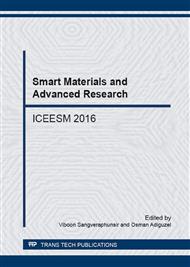p.7
p.12
p.17
p.22
p.27
p.32
p.37
p.46
p.51
Effect of Nickel Doping on Dielectric, Piezoelectric Properties and Domain Configurations of PZT Based Ceramics
Abstract:
The aims of present study were investigated the effect of nickel doping on the dielectric and piezoelectric properties of P(BN)ZT solid solution. P(BN)ZT powder doped with nickel nanoparticle in the composition of (1-x) PBNZT–xNi when x = 0, 2, 4, 6, 8 and 10 percent by mole. P(BN)ZT doped with nickel powder were calcined at 900 °C for 2 h and sintered at the temperature range of 1150 -1250°C for 2 h with heating/cooling rate of 5 °C/min. The dielectric constant (er) and the dielectric loss tangent (tand) of all ceramics were measured at room temperature using LCR meter. The piezoelectric properties (d33) were measured at room temperature using d33 meter. The micro and nano-domain structure was clearly observed by piezo-response force microscopy (PFM). From the results, it can be seen that the dielectric and piezoelectric decreased with increasing Ni particle of all composition (0.0-0.1 mol%). Moreover, PFM images show that the micro (180°) and nano (90°) domain are orientated at the surface region in submicron-scale of P(BN)ZT ceramics with doped nickel nanoparticle.
Info:
Periodical:
Pages:
27-31
Citation:
Online since:
January 2017
Authors:
Price:
Сopyright:
© 2017 Trans Tech Publications Ltd. All Rights Reserved
Share:
Citation:


